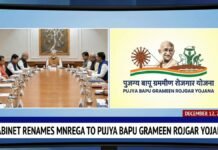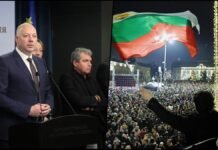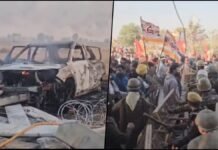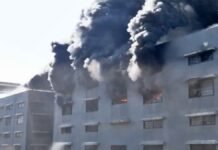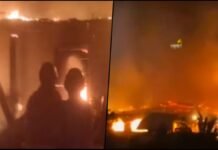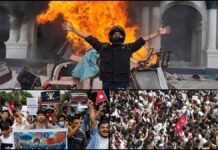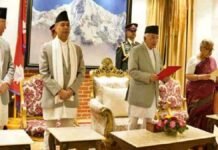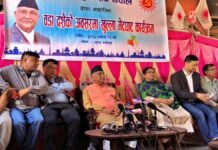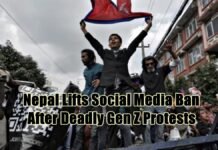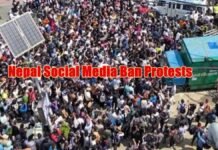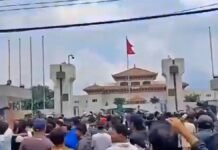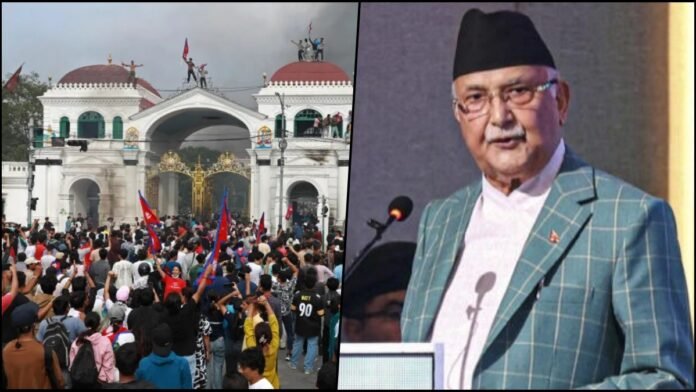
Key Points
- Criminal FIR filed against former PM KP Sharma Oli and ex-Home Minister Ramesh Lekhak at Kathmandu District Police Office on October 7, 2025
- 76 protesters killed during two-day Gen-Z protests on September 8-9, 2025; 19 died on first day alone in police firing
- Over 2,300 people injured during violent crackdown by security forces on anti-corruption demonstrations
- FIR forwarded to high-level Judicial Investigation Commission headed by Justice Gauri Bahadur Karki
- Security chiefs advised against immediate arrests following high-level meeting at PM residence; Nepal Army urges caution
- Protests erupted after government banned 26 social media platforms including Facebook, YouTube, X, and Instagram on September 4
- Oli resigned on September 9 after protesters surrounded Parliament; fled to army barracks at Budhanilkantha
- Former Chief Justice Sushila Karki appointed interim PM on September 12; general elections scheduled for March 5, 2026
- Gen-Z protesters used Discord servers and Instagram to coordinate massive demonstrations despite social media ban
- Parliament dissolved on September 13; candidate registration begins November 16-26, 2025
Kathmandu: In a dramatic legal development that marks a significant turning point in Nepal’s political crisis, youth activists from the Gen-Z Movement have filed a criminal First Information Report (FIR) against former Prime Minister KP Sharma Oli and former Home Minister Ramesh Lekhak at the Kathmandu District Police Office on Tuesday, October 7, 2025. The FIR seeks criminal accountability for the violent police crackdown during anti-government protests on September 8-9 that resulted in 76 deaths and injured over 2,300 people.
Historic FIR Against Former Leadership
Superintendent of Police Pawan Bhattarai, spokesperson for the Kathmandu District Police Circle, confirmed that the FIR was officially registered at the Kathmandu District Police Office in Bhadrakali against UML (Unified Marxist-Leninist) chairman Oli and Nepali Congress leader Lekhak. The complaint was filed by families of those killed and injured during the historic Gen-Z demonstrations that shook Nepal’s political establishment.
However, the process faced initial obstacles. When Sudhan Gurung and other complainants attempted to submit the FIR on Monday, October 6, police initially refused to register the complaint. Following intense pressure and a late-night emergency meeting among security chiefs, authorities agreed to accept the complaint on Tuesday.
The complaint also names Chhabilal Rijal, the then Chief District Officer of Kathmandu, as one of the respondents for his role in ordering or facilitating the security response that led to mass casualties.
Case Forwarded to Judicial Investigation Commission
Since a high-level probe commission has already been constituted to investigate the September violence, the police decided not to formally register and investigate the FIR themselves but instead forwarded it to the Judicial Investigation Commission headed by Justice Gauri Bahadur Karki. A senior police officer explained, “We have decided to receive the complaint and forward it to the Karki commission”.
Senior advocate Dinesh Tripathi emphasized the legal significance of this FIR, stating: “The FIR registered by the Gen-Z youths with the police will establish their (Oli and Lekhak’s) criminal accountability and pave the way for investigation of the crime committed on 8 and 9 September”. He added forcefully, “The serious crime committed by the state agents should not go unpunished, and impunity must be ended”.
The Karki-led commission now has the responsibility to thoroughly investigate the circumstances surrounding the deadly crackdown, examine the chain of command that authorized lethal force against protesters, and determine individual criminal responsibility for what many are calling state-sponsored violence against citizens exercising their democratic rights.
Security Chiefs Advise Caution on Arrests
The decision to accept the complaint followed a crucial high-level security meeting held at the Prime Minister’s official residence in Baluwatar on Monday evening, October 6. Prime Minister Sushila Karki convened chiefs of all four security agencies—Nepal Police, Armed Police Force, Nepal Army, and National Investigation Department—to discuss the mounting pressure to arrest Oli and other former officials implicated in the violence.
During this sensitive meeting, security heads reportedly advised against immediate arrests, citing potential complications and the risk of further destabilizing an already fragile political situation. The Nepal Army, in particular, suggested that the government proceed cautiously given the extreme sensitivity of arresting a former prime minister and the possible reactions from his substantial political base.
This cautious approach reflects the delicate balance the interim government must maintain—pursuing accountability for alleged state violence while avoiding actions that could trigger fresh unrest or military intervention in civilian governance.
The Deadly September 8-9 Protests
The Gen-Z Movement protests that erupted on September 8, 2025, represent one of the deadliest civilian demonstrations in Nepal’s recent history. On the first day alone, security forces killed 19 protesters through indiscriminate police firing on youth who had taken to the streets across Nepal. By the end of the second day, September 9, the death toll had tragically risen to at least 75-76 people, with more than 2,300 injured.
The protests began peacefully on September 8 as thousands of young Nepalese, predominantly Generation Z students and citizens, demonstrated against rampant corruption, government mismanagement of public funds, and the controversial nationwide ban on social media platforms. Demonstrators demanded an end to the ostentatious display of wealth by government officials’ families—the so-called “Nepo Kids”—while average citizens struggled with poverty, unemployment, and lack of opportunities.
According to witness accounts and media reports, security personnel opened fire indiscriminately on protesters, transforming peaceful demonstrations into scenes of carnage. The government’s violent response shocked the nation and international observers, particularly given that the protesters were largely unarmed young people exercising their constitutional rights to freedom of expression and assembly.
Escalation and Government Buildings Set Ablaze
The violence escalated dramatically on September 9, the second day of protests, as enraged demonstrators responded to the previous day’s killings. Protesters set fire to numerous strategic government buildings across Kathmandu, including parts of Singha Durbar (Nepal’s administrative headquarters), the adjacent Supreme Court building, the President’s residence at Sital Niwas, the Prime Minister’s residence at Baluwatar, and the headquarters of the Communist Party UML.
The Parliament building itself was surrounded by protesters and subsequently set on fire. The headquarters of both the UML and Nepali Congress parties were vandalized, with party flags stripped and burned in symbolic acts of popular rejection of the political establishment. Other buildings destroyed included the new Hilton Hotel in Kathmandu, the Ministry of Health building in Ramshahpath, and the offices of Kantipur media house, forcing the news organization to post updates on Facebook as its servers were damaged.
Security forces, including the Nepali Army, were deployed to facilitate the safe evacuation of politicians from affected areas, with many being moved to Tribhuvan International Airport (TIA). Protesters attempted to block political leaders from fleeing the country by occupying the airport, which was then closed by the Nepali Army. Hundreds of travelers were stranded, and scheduled international flights were diverted to Pokhara or cancelled entirely.
Minister of Agriculture Ram Nath Adhikari, Health Minister Pradip Paudel, along with 21 Members of Parliament from the Rastriya Swatantra Party resigned during the chaos. All MPs of the Rastriya Prajatantra Party also resigned, and several members abandoned Oli’s UML party as the government’s legitimacy collapsed.
Social Media Ban: The Spark That Ignited Revolution
The immediate trigger for the Gen-Z protests was the Government of Nepal’s decision on September 4, 2025, to shut down 26 social media platforms, including Facebook, X (formerly Twitter), YouTube, LinkedIn, Reddit, Signal, and Snapchat. The government justified this drastic measure by claiming these platforms had failed to register under the Ministry of Communication and Information Technology’s new regulatory rules.
According to official statements, the registration requirement was designed to enable enforcement of a new Digital Services Tax and stricter value-added tax rules on foreign e-service providers as part of efforts to boost government revenue. However, critics and protesters alleged the shutdown was actually motivated by a viral social media trend highlighting nepotism and focusing on the undue privileges enjoyed by children and relatives of influential political leaders—the “Nepo Kids” phenomenon that had sparked widespread public anger.
The social media ban had devastating economic implications for Nepal’s youth-dependent economy. With 33% of Nepal’s GDP coming from remittances sent by Nepalese working abroad, and approximately 20% youth unemployment domestically, hundreds of thousands of young Nepalese depend on social media platforms for employment, education, communication with family abroad, and economic opportunities in online spaces. The ban threatened the livelihoods of countless young people and severed vital communication channels in a country where rough terrain and substantial migration make digital connectivity essential.
Nepal has one of the highest social media usage rates in South Asia, with 48% of Nepalese having social media accounts compared to only 33.7% of Indians. With a median population age of 25 years, Generation Z constitutes a massive demographic that relies heavily on digital platforms. The government’s decision to ban these platforms was perceived as an assault on young people’s economic survival and democratic participation.
Digital Coordination Despite Government Ban
Despite the social media shutdown, or perhaps because of it, Gen-Z protesters demonstrated remarkable technological sophistication in organizing their movement. Youth participatory groups, particularly the non-governmental organization Hami Nepal, used Discord online communities (called “servers”) and Instagram channels as central organizing tools. The Hami Nepal Discord group was open to anyone to join, allowing for mass coordination of protest activities.
Protesters employed VPNs (Virtual Private Networks) to circumvent the government ban and posted physical flyers with QR codes that directed people to secure communication channels. This digital resistance demonstrated both the futility of the government’s censorship attempt and the technological savvy of Nepal’s youth generation.
According to media reports, tactical discussions on Discord included serious and controversial topics such as procurement of Molotov cocktails, advice to seize ammunition from police stations, and methods for disabling airplane tires using acetylene gas. After the deadly police response on September 8, organizers in some Discord servers called for indefinite closure of colleges and schools until the government accepted accountability for the killings.
Oli’s Resignation and Flight to Army Barracks
On September 9, as violence spiraled out of control and government buildings burned across Kathmandu, Prime Minister KP Sharma Oli made a final attempt to address the nation. He called on all parties to cease violent action but conspicuously failed to respond to the corruption allegations that had sparked the protests or acknowledge responsibility for the security forces’ deadly response.
Oli then directed his Communist Party of Nepal (Unified Marxist-Leninist) ministers not to resign their posts, but moments later resigned his own office as Prime Minister. Multiple reports allege that Nepali Army commander Ashok Raj Sigdel advised Oli to resign in order for the Army to restore peace and prevent further bloodshed.
Following his resignation, Oli fled to an army barracks in Shivapuri at Budhanilkantha, seeking protection from the military as protesters continued demanding accountability. There were conflicting reports about whether President Ram Chandra Poudel also resigned, though the Nepalese Army officially denied these reports.
Revolutionary Selection of Interim Leader
What happened next represents one of the most extraordinary examples of digital democracy in modern political history. After Oli’s resignation, the Army’s chiefs met with representatives of Hami Nepal and asked them to suggest nominees for an interim leader who would oversee national elections.
Between 10,000 (according to Al Jazeera English) and 100,000 (according to The New York Times) users met virtually in the Hami Nepal Discord channel to debate potential candidates. After extensive discussions, multiple polls, and the use of a dedicated sub-room for fact-checking claims about candidates, the members collectively settled on former Chief Justice Sushila Karki as their choice for interim prime minister.
Shaswot Lamichhane, a channel moderator and recent high school graduate, described the discussions as simulating a “mini-election”. Supporters of this unprecedented process viewed it as a revolutionary counter to the traditional practice of politicians choosing leaders behind closed doors with little transparency.
On September 12, 2025, President Ramchandra Poudel officially appointed Sushila Karki as head of the interim government, making her Nepal’s Prime Minister. On September 13, the President dissolved the 275-member Parliament and announced that general elections would be held on March 5, 2026.
Election Schedule and Democratic Transition
The Election Commission has established a comprehensive schedule for Nepal’s return to democratic governance through general elections. Key dates in the electoral calendar include:
November 15, 2025: Deadline for new political parties to register with the Election Commission
November 16-26, 2025: Candidate registration period for all established political parties
January 2-3, 2026: Political parties must submit their candidate lists under the proportional representation system
February 15 – March 2, 2026: Official campaign period of 15 days during which parties are permitted to actively campaign
March 5, 2026: Election Day, with voting scheduled from 7:00 AM to 5:00 PM across all polling stations
Vote counting will begin immediately after voting concludes on March 5, with results expected to be announced within days. This timeline provides approximately five months for political parties to reorganize, register candidates, and conduct campaigns following the tumultuous events of September 2025.
Gen-Z Movement Continues Demanding Accountability
Despite the formation of an interim government and the scheduling of elections, the Gen-Z Movement Alliance remains active and continues pressuring authorities for comprehensive accountability. On the same day the FIR was filed, the Alliance submitted a memorandum to the Commission for the Investigation of Abuse of Authority, demanding the resignation of Chief Commissioner Prem Kumar Rai and public hearings for all commissioners.
The movement has also denied rumors of planning another protest on October 9, with spokespersons clarifying that no official demonstration has been called. This clarification was welcomed by many who expressed concern that renewed protests could disrupt the fragile political transition.
However, protesters make clear that their struggle will continue until those responsible for the September violence face justice. The filing of the criminal FIR against Oli and Lekhak represents a crucial step in this ongoing quest for accountability, establishing legal grounds for criminal prosecution even as the political establishment attempts to move forward with elections.
Broader Context: Nepal’s Structural Challenges
The September Gen-Z protests and their violent suppression reflect deeper structural problems in Nepalese society that cannot be resolved merely through leadership changes or elections. According to analysis published in The Kathmandu Post, the average Nepali citizen earns only approximately $1,400 per year, creating stark inequality when juxtaposed with the ostentatious wealth displays by families of the ruling elite.
With 20% youth unemployment and limited domestic employment opportunities, Nepal issues hundreds of thousands of exit permits annually as young people seek work abroad. The resulting remittances—constituting 33% of GDP—keep thousands of households financially afloat and pay import bills, but also indicate a fundamental failure of economic development and structural transformation.
Commentators argue that while the Gen-Z revolt successfully toppled a government, true national transformation demands long-term, multi-dimensional changes to society, culture, and economy—a “multi-generational project” supported by education, empiricism, and a shift toward critical and productive mindsets. The root problems run deep in Nepal’s societal fabric, and overcoming them requires more than protests, government changes, and elections.
International Attention and Implications
The Gen-Z protests in Nepal have attracted significant international attention as a rare example of youth-led digital democracy successfully forcing regime change. The movement’s use of technology to coordinate protests and even select an interim leader represents a potential model for youth activism in other countries facing similar issues of corruption, nepotism, and authoritarian governance.
However, the extreme violence employed by security forces—resulting in 76 deaths—also serves as a stark reminder of the risks young activists face when challenging entrenched political power structures. The international community is closely watching how Nepal’s judicial system handles accountability for these deaths and whether the March 2026 elections will genuinely reflect the democratic aspirations expressed during the September uprising.
The criminal FIR filed against former Prime Minister Oli and former Home Minister Lekhak will serve as a critical test of Nepal’s commitment to justice and the rule of law. Whether these powerful political figures ultimately face prosecution, or whether they receive impunity through political maneuvering, will significantly impact Nepal’s democratic trajectory and the credibility of its institutions in the eyes of its young generation.
As Nepal moves toward elections scheduled for March 5, 2026, the Gen-Z Movement continues to demand that the voices of those 76 killed protesters are not forgotten and that their deaths lead to genuine political transformation rather than merely a reshuffling of the same corrupt political elites.


